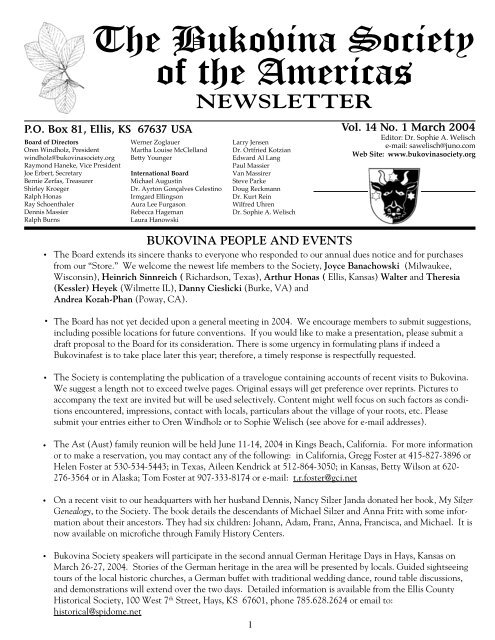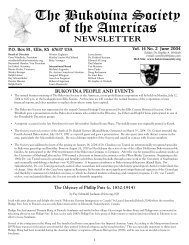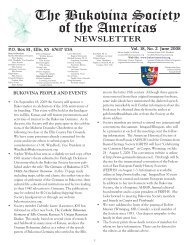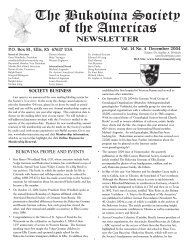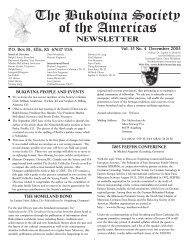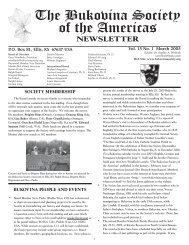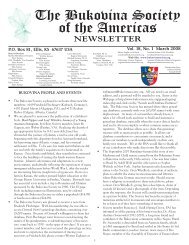March 2004 Vol. 14 #1 - Bukovina Society of the Americas
March 2004 Vol. 14 #1 - Bukovina Society of the Americas
March 2004 Vol. 14 #1 - Bukovina Society of the Americas
You also want an ePaper? Increase the reach of your titles
YUMPU automatically turns print PDFs into web optimized ePapers that Google loves.
Board <strong>of</strong> Directors<br />
Oren Windholz, President<br />
windholz@bukovinasociety.org<br />
Raymond Haneke, Vice President<br />
Joe Erbert, Secretary<br />
Bernie Zerfas, Treasurer<br />
Shirley Kroeger<br />
Ralph Honas<br />
Ray Schoenthaler<br />
Dennis Massier<br />
Ralph Burns<br />
The <strong>Bukovina</strong> <strong>Society</strong><br />
<strong>of</strong> <strong>the</strong> <strong>Americas</strong><br />
NEWSLETTER<br />
P.O. Box 81, Ellis, KS 67637 USA<br />
.<br />
.<br />
.<br />
.<br />
.<br />
.<br />
Werner Zoglauer<br />
Martha Louise McClelland<br />
Betty Younger<br />
International Board<br />
Michael Augustin<br />
Dr. Ayrton Gonçalves Celestino<br />
Irmgard Ellingson<br />
Aura Lee Furgason<br />
Rebecca Hageman<br />
Laura Hanowski<br />
Larry Jensen<br />
Dr. Ortfried Kotzian<br />
Edward Al Lang<br />
Paul Massier<br />
Van Massirer<br />
Steve Parke<br />
Doug Reckmann<br />
Dr. Kurt Rein<br />
Wilfred Uhren<br />
Dr. Sophie A. Welisch<br />
BUKOVINA PEOPLE AND EVENTS<br />
<strong>Vol</strong>. <strong>14</strong> No. 1 <strong>March</strong> <strong>2004</strong><br />
Editor: Dr. Sophie A. Welisch<br />
e-mail: sawelisch@juno.com<br />
Web Site: www.bukovinasociety.org<br />
The Board extends its sincere thanks to everyone who responded to our annual dues notice and for purchases<br />
from our “Store.” We welcome <strong>the</strong> newest life members to <strong>the</strong> <strong>Society</strong>, Joyce Banachowski (Milwaukee,<br />
Wisconsin), Heinrich Sinnreich ( Richardson, Texas), Arthur Honas ( Ellis, Kansas) Walter and Theresia<br />
(Kessler) Heyek (Wilmette IL), Danny Cieslicki (Burke, VA) and<br />
Andrea Kozah-Phan (Poway, CA).<br />
The Board has not yet decided upon a general meeting in <strong>2004</strong>. We encourage members to submit suggestions,<br />
including possible locations for future conventions. If you would like to make a presentation, please submit a<br />
draft proposal to <strong>the</strong> Board for its consideration. There is some urgency in formulating plans if indeed a<br />
<strong>Bukovina</strong>fest is to take place later this year; <strong>the</strong>refore, a timely response is respectfully requested.<br />
The <strong>Society</strong> is contemplating <strong>the</strong> publication <strong>of</strong> a travelogue containing accounts <strong>of</strong> recent visits to <strong>Bukovina</strong>.<br />
We suggest a length not to exceed twelve pages. Original essays will get preference over reprints. Pictures to<br />
accompany <strong>the</strong> text are invited but will be used selectively. Content might well focus on such factors as conditions<br />
encountered, impressions, contact with locals, particulars about <strong>the</strong> village <strong>of</strong> your roots, etc. Please<br />
submit your entries ei<strong>the</strong>r to Oren Windholz or to Sophie Welisch (see above for e-mail addresses).<br />
The Ast (Aust) family reunion will be held June 11-<strong>14</strong>, <strong>2004</strong> in Kings Beach, California. For more information<br />
or to make a reservation, you may contact any <strong>of</strong> <strong>the</strong> following: in California, Gregg Foster at 415-827-3896 or<br />
Helen Foster at 530-534-5443; in Texas, Aileen Kendrick at 512-864-3050; in Kansas, Betty Wilson at 620-<br />
276-3564 or in Alaska; Tom Foster at 907-333-8174 or e-mail: t.r.foster@gci.net<br />
On a recent visit to our headquarters with her husband Dennis, Nancy Silzer Janda donated her book, My Silzer<br />
Genealogy, to <strong>the</strong> <strong>Society</strong>. The book details <strong>the</strong> descendants <strong>of</strong> Michael Silzer and Anna Fritz with some information<br />
about <strong>the</strong>ir ancestors. They had six children: Johann, Adam, Franz, Anna, Francisca, and Michael. It is<br />
now available on micr<strong>of</strong>iche through Family History Centers.<br />
<strong>Bukovina</strong> <strong>Society</strong> speakers will participate in <strong>the</strong> second annual German Heritage Days in Hays, Kansas on<br />
<strong>March</strong> 26-27, <strong>2004</strong>. Stories <strong>of</strong> <strong>the</strong> German heritage in <strong>the</strong> area will be presented by locals. Guided sightseeing<br />
tours <strong>of</strong> <strong>the</strong> local historic churches, a German buffet with traditional wedding dance, round table discussions,<br />
and demonstrations will extend over <strong>the</strong> two days. Detailed information is available from <strong>the</strong> Ellis County<br />
Historical <strong>Society</strong>, 100 West 7<br />
1<br />
th Street, Hays, KS 67601, phone 785.628.2624 or email to:<br />
historical@spidome.net
EASTER WATER<br />
by Irmgard Hein Ellingson (Grafton, IA)<br />
A lively e-mail discussion by members <strong>of</strong> <strong>the</strong> <strong>Bukovina</strong>-Gen List last spring<br />
prompted Board member Irmgard Hein Ellingson fur<strong>the</strong>r to research <strong>the</strong><br />
background <strong>of</strong> <strong>the</strong> Easter custom <strong>of</strong> sprinkling water on members <strong>of</strong> <strong>the</strong><br />
opposite sex on Easter Monday and Easter Tuesday. The custom entered<br />
<strong>Bukovina</strong> through <strong>the</strong> diocesan link between Galicia and <strong>Bukovina</strong>, which<br />
continued until after World War I. Bukovinians studying for <strong>the</strong> priesthood<br />
usually pursued <strong>the</strong>ir <strong>the</strong>ological studies at <strong>the</strong> University <strong>of</strong> Lemberg<br />
(Lvov), Galicia, which had been Polonized in 1871. The majority <strong>of</strong> <strong>the</strong><br />
hierarchy serving <strong>Bukovina</strong> were Poles as were most <strong>of</strong> <strong>the</strong> parish priests,<br />
although German Catholics outnumbered Polish Catholics 3:1. (editor)<br />
Easter was <strong>the</strong> major holiday <strong>of</strong> <strong>the</strong> church year for <strong>the</strong> Christian<br />
people <strong>of</strong> Central and Eastern Europe, including those in <strong>Bukovina</strong>.<br />
Ancient folklore was incorporated with religious tradition in lively<br />
festivities that celebrated life made new at springtime. Water, <strong>the</strong><br />
natural element that was believed to convey a special measure <strong>of</strong><br />
God’s grace, was used in abundance.<br />
In <strong>the</strong> early Christian church new believers were instructed in <strong>the</strong><br />
faith during Lent and <strong>the</strong>n baptized at Easter. Baptism and water have<br />
<strong>the</strong>refore been historically associated with <strong>the</strong> celebration <strong>of</strong> <strong>the</strong><br />
Resurrection <strong>of</strong> Jesus Christ throughout <strong>the</strong> centuries.<br />
The Roman Catholic tradition includes <strong>the</strong> use <strong>of</strong> holy water, which<br />
has been blessed by <strong>the</strong> priest with a prayer to ask God’s blessing on<br />
those who use it and God’s protection from <strong>the</strong> powers <strong>of</strong> darkness. To<br />
use this water with a symbol such as making <strong>the</strong> sign <strong>of</strong> <strong>the</strong> cross<br />
recalls one’s own baptism.<br />
The water blessed on Holy Saturday, or Easter Water, as it is called,<br />
differs from holy water blessed at o<strong>the</strong>r times in one regard: <strong>the</strong> Easter<br />
water has been blessed with greater solemnity when <strong>the</strong> paschal<br />
candle, which represents Our Lord risen from <strong>the</strong> dead, was dipped<br />
into it one or three times with a special prayer. This Easter Water is<br />
<strong>the</strong>n used for <strong>the</strong> administration <strong>of</strong> <strong>the</strong> Sacrament <strong>of</strong> Holy Baptism<br />
throughout <strong>the</strong> year, although <strong>the</strong> use <strong>of</strong> ordinary water is also valid<br />
(see http://landru.i-link-2.net/shnyves/holy_water2.htm, for example).<br />
Polish Catholics have <strong>the</strong> tradition <strong>of</strong> squirting or drenching one<br />
ano<strong>the</strong>r on Dyngus, or Easter Monday, which is also called Wet<br />
Monday. Boys chased <strong>the</strong> girls to get <strong>the</strong>m wet on Easter Monday and<br />
<strong>the</strong>n it was supposed to be <strong>the</strong> girls’ turn to chase <strong>the</strong> boys <strong>the</strong> next<br />
day. Poland’s Dyngu, or Smigus Day is based upon <strong>the</strong> baptism <strong>of</strong> <strong>the</strong><br />
founder <strong>of</strong> Polish Christianity, Prince Mieszko I (ruled 962 -992) and<br />
his entire court on Easter Monday 966. As a result, all Poland was<br />
united under Christian rule. Dyngus is still observed in <strong>the</strong> country<br />
and in <strong>the</strong> cities with singing, pranks, visiting, and water dousings (see<br />
Pip Wilson’s “Poland’s Dyngus Day, and o<strong>the</strong>r Easter Monday Customs”<br />
posted online at http://www.wilsonsalmanac.com/<br />
eastmond.html).<br />
Various German traditions are associated with Easter Water.<br />
Osterwasser, or water dipped silently from a stream on Easter morning,<br />
was considered to have special powers to protect humans and animals<br />
from sickness. Children baptized with its water were supposed to have<br />
unique intelligence. When this water was sprinkled in a house, it was<br />
a safeguard against vermin. In some rural communities, a girl was<br />
2<br />
supposed silently to fetch water from a spring or stream and wash<br />
with it before dawn on Easter morning, taking care not to meet<br />
anyone on <strong>the</strong> way, in order to receive special blessings. Girls would<br />
also chase boys with water because it was believed that if a girl could<br />
sprinkle a boy with Easter water, <strong>the</strong>y would soon be married.<br />
Joel Streich <strong>of</strong> New York translated <strong>the</strong> following from <strong>the</strong> book Der<br />
Kreis Wirsitz [Posen] in 1999. It is posted at “http://<br />
members.tripod.com/~radde/EasterWater.html”http://<br />
members.tripod.com/~radde/EasterWater.html:<br />
“In earlier times <strong>the</strong>re was a custom to put away Easter Water (for<br />
use) against skin and eye ailments. One had to scoop <strong>the</strong> water from<br />
a pure, flowing brook in <strong>the</strong> earliest Easter Sunday hours before<br />
sunrise and one may meet no one and speak to no one. Whoever<br />
washed himself on Easter Day with such water remained protected<br />
from skin and eye ailments.<br />
“One saw young girls wending <strong>the</strong>ir way to <strong>the</strong> nearest clear stream<br />
in <strong>the</strong> gray early morning hours to ga<strong>the</strong>r <strong>the</strong> water which was<br />
supposed to bestow beauty and virtue. The way <strong>the</strong>re and home<br />
again had to be paced silently. That wasn’t easy since young boys<br />
and envious women attempted to hinder <strong>the</strong>m with that, to startle<br />
<strong>the</strong>m and to tempt <strong>the</strong>m into idle conversation. If <strong>the</strong>y were<br />
successful, <strong>the</strong> Easter Water would turn to desecrated Schladder-water<br />
and <strong>the</strong> maidens would become <strong>the</strong> scorn <strong>of</strong> all.<br />
“The earlier one made <strong>the</strong> pilgrimage to <strong>the</strong> spring, <strong>the</strong> fewer<br />
tempters one would meet. This Easter event had ano<strong>the</strong>r purpose<br />
that <strong>the</strong> children and adults pursued. In <strong>the</strong> rising sun, just when <strong>the</strong><br />
sun’s red ball appeared and spread to its full might, one saw <strong>the</strong><br />
Easter lamb jump. A beautiful custom, that, with <strong>the</strong> power <strong>of</strong> belief,<br />
<strong>the</strong> jumping <strong>of</strong> <strong>the</strong> Easter lamb actually let itself be seen in <strong>the</strong> sun’s<br />
ball during <strong>the</strong> awakening <strong>of</strong> spring and in <strong>the</strong> early mist <strong>of</strong> <strong>the</strong><br />
steaming earth.”<br />
Ukrainian Easter traditions are depicted by Orysia Paszczak Tracz: “.<br />
. . Water and fire are two forces that have been used in rituals since<br />
time immemorial. The blessing with holy water and candles in<br />
church are two reminders <strong>of</strong> how important <strong>the</strong>se have always been<br />
in all kinds <strong>of</strong> rituals. Water symbolizes many things: <strong>the</strong> fountain <strong>of</strong><br />
life, for humans, animals and all aspects <strong>of</strong> nature; a force <strong>of</strong> nature<br />
to be both worshiped and feared; cleansing, purity and truth; health<br />
and strength (Bud zdorovyi yak voda - Be as healthy as <strong>the</strong> water); <strong>the</strong><br />
force <strong>of</strong> motion; danger (fast water); time (Vchorashnoyi vody ne<br />
dozhenesh - You cannot catch up to yesterday’s water); persistence<br />
(Tykha voda berehy lomyt - Quiet water breaks down <strong>the</strong> riverbanks).<br />
“But most importantly, especially for Easter Monday, water symbolizes<br />
love, courting, marriage and a young woman.<br />
“The day after Easter Sunday is called Oblyvanyi (drenching) or<br />
<strong>Vol</strong>ochebnyi or <strong>Vol</strong>ochivnyi (Wandering) Monday. This is <strong>the</strong> day<br />
when <strong>the</strong> young men pour water on <strong>the</strong> young women, especially on<br />
<strong>the</strong>ir swee<strong>the</strong>arts. Some divchata or divky (young eligible women)<br />
were even drenched through <strong>the</strong> windows <strong>of</strong> <strong>the</strong>ir house. No one<br />
slept late that morning, for fear that <strong>the</strong> bed also would be drenched.<br />
As noted by Hryhory Luzhnytsky, even in <strong>the</strong> cities this custom was<br />
popular, to <strong>the</strong> extent that people emptied <strong>the</strong>ir rooms <strong>of</strong> furniture,<br />
in order to avoid water damage.<br />
“And, this was an equal opportunity tradition, because on Easter<br />
Tuesday, “Oblyvanyi Vivtorok,” <strong>the</strong> young women drenched <strong>the</strong>
young men. [It has been] observed that <strong>the</strong> ritual should have been<br />
called ‘bathing’ instead <strong>of</strong> drenching, because originally, beginning in<br />
<strong>the</strong> early morning, young people dragged each o<strong>the</strong>r into <strong>the</strong> streams,<br />
ponds and rivers in <strong>the</strong> village. Any water vessel would do, whe<strong>the</strong>r<br />
being thrown into a trough, or drenched by any means (with buckets,<br />
etc.). One indication that this was a courting ritual is that married<br />
women were not drenched. In addition to <strong>the</strong> romantic connotation,<br />
<strong>the</strong> water drenching was to bring health and happiness, and to<br />
encourage rainfall . . . “<br />
Tracz notes that <strong>the</strong> Hutsuly <strong>of</strong> <strong>the</strong> Carpathian Mountains did not<br />
observe <strong>the</strong> custom <strong>of</strong> drenching one ano<strong>the</strong>r on <strong>Vol</strong>ochivnyi<br />
Ponedilok, Easter Monday. The exquisite Hutsul clothing is not at all<br />
suited for water immersion. Ra<strong>the</strong>r, <strong>the</strong>ir young men went from house<br />
to house collecting pysanky or Easter eggs, from those with whom <strong>the</strong>y<br />
had danced during <strong>the</strong> year. Each girl was obligated to give her<br />
dancing partner a pysanka when he came to <strong>the</strong> door, <strong>the</strong>n invite him<br />
in for food and drink. In some areas a young woman who did not give<br />
a pysanka could be drenched.<br />
Orysia Paszczak Tracz’s article “Our Easter Traditions: ‘Drenching<br />
Monday’” was published in <strong>the</strong> The Ukrainian Weekly, April 11,<br />
1999, No. 15, <strong>Vol</strong>. LXVII and has been posted online at http://<br />
www.ukrweekly.com/Archive/1999/159929.shtml.<br />
Easter Monday customs continue into <strong>the</strong> present. Easter Monday is<br />
listed in <strong>the</strong> Canada Labour Code as a holiday and is celebrated as a<br />
statutory holiday in most parts <strong>of</strong> Canada except British Columbia.<br />
The Canadian web page http://www.calendar-updates.com/Holidays/<br />
Canada/eastermonday.htm notes that “ ... Early Christians celebrated<br />
<strong>the</strong> days immediately following Easter - <strong>the</strong> most important holy day<br />
in <strong>the</strong> Christian church - by telling jokes, playing pranks, and feasting<br />
on lamb. People would add fragrant oil or perfume to <strong>the</strong> Easter Water<br />
<strong>the</strong>y brought home from church, and <strong>the</strong>n use it to sprinkle and bless<br />
<strong>the</strong>ir food, pets, gardens, and homes.<br />
“On Easter Monday morning, men would wake <strong>the</strong>ir wives with a<br />
Spritz <strong>of</strong> <strong>the</strong> perfumed Easter water as <strong>the</strong>y whispered, ‘May you never<br />
wi<strong>the</strong>r.’ On Easter Tuesday, women would return <strong>the</strong> favor as <strong>the</strong>y<br />
awakened <strong>the</strong>ir husbands with a bucketful <strong>of</strong> <strong>the</strong> scented water!”<br />
May your Easter celebrations this year be heightened with a renewed<br />
appreciation <strong>of</strong> water, light, and life!<br />
BUKOVINA-GERMAN<br />
IMMIGRATION TO CANADA*<br />
by Laura Hankowski (Regina, Saskatchewan, Canada)<br />
The immigration <strong>of</strong> <strong>Bukovina</strong>-Germans to Canada began in <strong>the</strong> late<br />
1880s.This came about as a result <strong>of</strong> <strong>the</strong> Dominion <strong>of</strong> Canada’s need<br />
for farmers to settle <strong>the</strong> prairie provinces. To promote immigration<br />
<strong>the</strong> government <strong>of</strong>fered a free homestead consisting <strong>of</strong> 160 acres <strong>of</strong><br />
land for a $10 registration fee. Homesteads became available to men<br />
twenty-one years or older and women who were <strong>the</strong> sole support <strong>of</strong><br />
<strong>the</strong>ir families. However, one could apply for a homestead at age<br />
eighteen and complete <strong>the</strong> requirements by <strong>the</strong> time <strong>the</strong> applicant<br />
reached twenty-one. To qualify <strong>the</strong> applicant had to break and crop<br />
thirty acres <strong>of</strong> land, live on <strong>the</strong> homestead for at least six months <strong>of</strong><br />
<strong>the</strong> year, build a substantial home, raise animals and fence in some<br />
3<br />
<strong>of</strong> <strong>the</strong> land. Before receiving <strong>the</strong> patent for <strong>the</strong> land <strong>the</strong> applicant<br />
also had to become a naturalized British subject. Once <strong>the</strong> requirements<br />
for <strong>the</strong> free homestead had been met, <strong>the</strong> homesteader could<br />
apply for a pre-emption or purchase a homestead <strong>of</strong> an additional<br />
160 acres at a fixed amount, usually at <strong>the</strong> rate <strong>of</strong> $3 per acre.<br />
The majority <strong>of</strong> <strong>Bukovina</strong> Germans who took up this <strong>of</strong>fer <strong>of</strong> free<br />
land came to Saskatchewan. In 1885 <strong>the</strong> first settlers included a<br />
group <strong>of</strong> Baptists from <strong>the</strong> Dobruja, at that time in Bulgaria. It<br />
should be noted that its leader, Philip Butz, was born in Fratautz,<br />
<strong>Bukovina</strong>. By 1889 he had convinced <strong>the</strong> Lu<strong>the</strong>ran families <strong>of</strong><br />
Galenzoski, Mang, Reichel and Sauer from Satulmare as well as <strong>the</strong><br />
Kornelson family <strong>of</strong> Itzkany to immigrate to Canada. They called<br />
<strong>the</strong>ir new settlement Neu-Tulscha or Neu Tulcea, a name later<br />
changed to Edenwold. As <strong>the</strong> population increased, new communities<br />
sprang up including Arat, Earl Grey, Elbourne, Kennell,<br />
Markinch, Silton, Sou<strong>the</strong>y, Vilbank and Zehner. Their inhabitants<br />
were primarily Protestants from <strong>the</strong> Bukovinian communities <strong>of</strong><br />
Arbora, Badeutz, Czernowitz, Fratautz, Illischestie, Itzkany, Radautz,<br />
Satulmare, St. Onufry, Sereth, Suczawa, and Tereblestie.<br />
Shortly after <strong>the</strong>ir arrival <strong>the</strong> settlers built churches, <strong>the</strong> first being<br />
<strong>the</strong> Edenwold Baptist Church (1886-1968). St. John’s Evangelical<br />
Lu<strong>the</strong>ran Church celebrated <strong>the</strong> centennial <strong>of</strong> its founding in 1992<br />
by publishing a history <strong>of</strong> <strong>the</strong> church and <strong>the</strong> members <strong>of</strong> <strong>the</strong><br />
congregation. The first records were in German and kept just as <strong>the</strong>y<br />
had been in <strong>Bukovina</strong>. This means that <strong>the</strong> names <strong>of</strong> parents and<br />
places <strong>of</strong> origin in <strong>Bukovina</strong> were cited in <strong>the</strong> early baptism,<br />
marriage and death records. O<strong>the</strong>r churches serving <strong>the</strong>se early<br />
pioneers included <strong>the</strong> Edenwold Seventh-Day Adventist Church<br />
founded in 1900 and <strong>the</strong> Edenwold Apostolic Mission (1921-1957).<br />
The establishment <strong>of</strong> nearby settlements necessitated <strong>the</strong> building <strong>of</strong><br />
churches to look after <strong>the</strong>ir spiritual needs.<br />
Many <strong>of</strong> <strong>the</strong> early Roman Catholic records can be found in <strong>the</strong><br />
church registries for Regina. The first Roman Catholics from<br />
<strong>Bukovina</strong> came to <strong>the</strong> Mariahilf, Killaly and Grayson districts from<br />
Czernowitz, Dereluj, Kuczumare, Molodia, Rosch and Woloka. John<br />
Hubenig <strong>of</strong> Rosch came to Canada in 1890 to investigate <strong>the</strong> <strong>of</strong>fer<br />
<strong>of</strong> free land. He got <strong>of</strong>f <strong>the</strong> train at Grenfell and made his way on<br />
foot to what came to be known as Hyde. Satisfied that <strong>the</strong>re was<br />
land with <strong>the</strong> potential <strong>of</strong> supporting his family for years to come, he<br />
returned to <strong>Bukovina</strong> with <strong>the</strong> news. In 1893 he immigrated to<br />
Hyde, where he established a permanent home and prepared his<br />
land for crops.<br />
In 1897 <strong>the</strong> families <strong>of</strong> Heinrich Exner, Anton Rieger and Anton J.<br />
Flegel arrived from Molodia to establish <strong>the</strong> settlement <strong>of</strong> Mariahilf.<br />
In 1898 <strong>the</strong>y were joined by 165 people including twenty-five<br />
families and three bachelors from Molodia and Rosch: Georg Baer,<br />
Kasper Beutel, Ferdinand Dian, Jakob Dietrich, Johann Dietrich,<br />
Anton Exner, Johann Exner, Anton G. Flegel, Johann J. Flegel,<br />
Josef G. Flegel, Franz Fuchs, Anton Hanowski, Sebastian Hanowski,<br />
Wilhelm Hanowski, Heinrich Holitzki, Johann Holitzki, Johann<br />
Hornung, Josef Lang, Anton Ludwar, Adam Nestmann, Johann<br />
Nowak, Andrew Rogalski, Jakob Ruehr, Josef Seida, and Franz, Josef<br />
and Michael Horning. The year 1900 witnessed <strong>the</strong> arrival <strong>of</strong> fortynine<br />
o<strong>the</strong>r immigrants from Molodia including <strong>the</strong> families <strong>of</strong> Eva<br />
Hartmann, Adam Hornung, Johann Huber, Leonard Mayer, Josef<br />
Neumann, Anton Ottenbreit, Robert Schultz and Josef Stepan, plus<br />
Andreas Franz, Johann Bank, Georg Hartmann, Geog Lang and Karl<br />
Lang. The development <strong>of</strong> <strong>the</strong> homestead land resulted in <strong>the</strong>
communities <strong>of</strong> Killaly and Grayson wherein settled <strong>the</strong> Appel,<br />
Batza, Baumgartner, Duczek, Fuchs, Gelowitz, Hicke, Huber,<br />
Kopetski, Lichtenwald, Ludwar, Ruehr, Stadecki, Zaleski and<br />
Zimmer families, who continued to immigrate from <strong>Bukovina</strong>. By<br />
1904 most <strong>of</strong> <strong>the</strong> available homestead land in <strong>the</strong>se areas was<br />
occupied, leading <strong>the</strong> sons <strong>of</strong> <strong>the</strong> original settlers and <strong>the</strong> new<br />
immigrants to move on to Spring Valley, Claybank and Bayard.<br />
Shortly after <strong>the</strong> first settlers arrived, <strong>the</strong>y approached Archbishop<br />
Adelard Langevin <strong>of</strong> St. Boniface, Manitoba, to ask that a priest visit<br />
<strong>the</strong>ir community. Until construction <strong>of</strong> <strong>the</strong> chapel at Mariahilf in<br />
1900 <strong>the</strong> priest conducted monthly services in <strong>the</strong> homes <strong>of</strong> <strong>the</strong><br />
parishioners. In 1907 St. Mary’s Church was built in Grayson<br />
followed in 1910 by St. Elizabeth’s Church in Killaly. Until <strong>the</strong><br />
completion <strong>of</strong> <strong>the</strong> Lu<strong>the</strong>ran church in Killaly (1926), <strong>the</strong> Lu<strong>the</strong>rans<br />
likewise held religious services in private homes and schools. Church<br />
records for all <strong>the</strong>se parishes are extant and where needed, new<br />
markers have been placed on many <strong>of</strong> <strong>the</strong> “unknown” graves to<br />
memorialize <strong>the</strong> names <strong>of</strong> <strong>the</strong>se early pioneers.<br />
The settlers valued education. No sooner had <strong>the</strong> families established<br />
<strong>the</strong>ir communities than <strong>the</strong>y requested permission to set up<br />
school districts. Until <strong>the</strong> outbreak <strong>of</strong> <strong>the</strong> First World War many <strong>of</strong><br />
<strong>the</strong> schools used German as <strong>the</strong> language <strong>of</strong> instruction.<br />
Communication among <strong>the</strong> settlers was facilitated through <strong>the</strong><br />
Saskatchewan Courier, a German-language newspaper published in<br />
Regina from 1907. Through letters to <strong>the</strong> editor <strong>the</strong>y carried on<br />
lively debates about current agricultural practices and politics. Each<br />
community usually had a column, which noted local happenings.<br />
Issues <strong>of</strong> <strong>the</strong> newspaper have been micr<strong>of</strong>ilmed and are available to<br />
anyone interested in reading about <strong>the</strong> lives <strong>of</strong> <strong>the</strong>se early settlers.<br />
While in Canada <strong>the</strong>re is no formal association <strong>of</strong> <strong>the</strong> descendants <strong>of</strong><br />
<strong>the</strong> Germans from <strong>Bukovina</strong>, <strong>the</strong>re are many opportunities to learn<br />
more about genealogy, culture, history and traditions relating to<br />
<strong>Bukovina</strong> and Bukovinians. Mention might here be made <strong>of</strong> <strong>the</strong><br />
<strong>Bukovina</strong> <strong>Society</strong> <strong>of</strong> <strong>the</strong> <strong>Americas</strong> at P. O. Box 1083, Hays, KS<br />
67601, USA and to its web site at http://www.bukovinasociety.org><br />
Those who read German may wish to check with <strong>the</strong><br />
Landsmannschaft der Buchenlanddeutschen or <strong>the</strong> Bukowina Institut,<br />
both at Alter Postweg 97a, 86159 Augsburg, Germany or <strong>the</strong>ir email<br />
address at bukinst@t-online.de> There is also <strong>the</strong> <strong>Bukovina</strong><br />
Genealogy List at buko-gen.html which <strong>of</strong>fers subscribers an<br />
opportunity to ask questions, exchange views, and enter into a dialog<br />
with like-minded Bukovinian researchers on a global scale. Many<br />
descendants <strong>of</strong> <strong>the</strong> first Bukovinian immigrants to Canada are<br />
continuing <strong>the</strong>ir association with <strong>Bukovina</strong> ei<strong>the</strong>r through visits to<br />
<strong>the</strong>ir ancestral villages, through genealogical research or through <strong>the</strong><br />
internet.<br />
Right here at home <strong>the</strong> Saskatchewan Genealogical <strong>Society</strong> (SGS)<br />
<strong>of</strong>fers programs in genealogical research using <strong>the</strong> resources <strong>of</strong> <strong>the</strong><br />
SGS Library, which includes maps, histories and actual church<br />
records for Bukovinian communities. Many individuals have<br />
completed extensive histories about <strong>the</strong>ir families and have deposited<br />
copies in <strong>the</strong> library. In addition, Saskculture at http://<br />
www.Saskculture.sk.ca> serves as an umbrella organization for <strong>the</strong><br />
many diverse cultural groups in Saskatchewan. One such group is<br />
<strong>the</strong> Saskatchewan German Council http://saskgermancouncil.org><br />
which works to promote and preserve culture, language, customs,<br />
4<br />
traditions and interests <strong>of</strong> Saskatchewans <strong>of</strong> German-speaking<br />
backgrounds. Those willing to expend <strong>the</strong> effort will undoubtedly<br />
find <strong>the</strong> resources to enrich <strong>the</strong>ir knowledge <strong>of</strong> <strong>Bukovina</strong> and its<br />
people.<br />
*The author is a certified Saskatchewan Researcher and Educational<br />
Coordinator <strong>of</strong> <strong>the</strong> Saskatchewan Genealogical <strong>Society</strong> (SGS). The<br />
article presented here has been reprinted from SGS Bulletin, vol. 34<br />
(June 2003): 43-45. It appeared in German translation in Der<br />
Südostdeutsche (Augsburg), June 20, 2003, pp. 1, 8.<br />
KARL FLACHS<br />
IN MEMORIUM<br />
by Al Lang (Sycamore, IL)<br />
When I heard <strong>of</strong> <strong>the</strong> passing <strong>of</strong><br />
Karl Flachs, I was deeply saddened,<br />
as I had not only lost a<br />
relative but also a very dear friend.<br />
Born on July 7, 1923 in <strong>the</strong><br />
German-Bohemian village <strong>of</strong><br />
Pojana Mikuli (aka Buchenhain), <strong>Bukovina</strong>, Karl experienced in full<br />
measure <strong>the</strong> poignancy <strong>of</strong> resettlement, flight and expulsion, which<br />
befell <strong>the</strong> <strong>Bukovina</strong> Germans in <strong>the</strong> wake <strong>of</strong> World War II. His final<br />
years were spent in Waldkraiburg, Germany, where he died on<br />
November 21, 2003.<br />
I vividly recall my first meeting with Karl, at which a mutual<br />
relative, using <strong>the</strong> German-Bohemian dialect, introduced me as<br />
follows: “Karl, kennst du no’ den Lang Ignaz. Er ist von dem Lang, a’<br />
Bua, no’ a’ Bua, und no’ amol a’ Bua.” (Karl, you still remember<br />
Ignaz Lang. Of Ignatz he is a son, yet ano<strong>the</strong>r son, and <strong>the</strong>n yet<br />
ano<strong>the</strong>r son.), i.e., he is <strong>the</strong> great-grandson <strong>of</strong> Ignaz Lang. At that<br />
moment Karl and I bonded through common language, tradition and<br />
genealogy.<br />
A truly genuine and honest man, Karl welcomed everyone as a<br />
friend. With me he shared <strong>the</strong> fact that he <strong>of</strong>ten thought fondly <strong>of</strong><br />
his relatives in Brazil and in <strong>the</strong> United States, although he lamented<br />
<strong>the</strong> Americanization <strong>of</strong> <strong>the</strong> family name to Flax. It also<br />
disturbed him that World War II had pitted family against family on<br />
<strong>the</strong> battlefield.<br />
Karl confirmed stories I had heard about <strong>Bukovina</strong> as a child;<br />
moreover, he seemed surprised and pleased that <strong>the</strong>se stories had<br />
survived three generations in America. We exchanged folklore<br />
including tales <strong>of</strong> ghosts and goblins. But most importantly we spent<br />
many hours pouring over his voluminous genealogical documents<br />
including Ahnenpässe (genealogical charts issued for payment to<br />
Bukovinians who resettled in Germany in 1940). I vividly recall<br />
Karl’s passion for accuracy. When he discovered an error in an<br />
Ahnenpass, he vociferously expressed his frustration at <strong>the</strong> money<br />
spent in vain for supposedly accurate genealogical data from church<br />
records. Errors were unacceptable to Karl.
His documentation and personal involvement proved indispensable<br />
in <strong>the</strong> compilation <strong>of</strong> my book, Bukowina Families 200 Years:<br />
Genealogy <strong>of</strong> Many <strong>of</strong> <strong>the</strong> Catholic Bohemian Families That Emigrated<br />
to Bukowina between <strong>the</strong> Years 1799 and 1842, and Later to <strong>the</strong> United<br />
States, Germany and Brazil with Reference to Emigrees to Canada<br />
(1993). To those who may be interested, this book is available<br />
through <strong>the</strong> <strong>Bukovina</strong> <strong>Society</strong>.<br />
In his book Os Bucovinos do Brasil . . . e a História de Rio Negro (The<br />
Bukovinians <strong>of</strong> Brazil . . . and a History <strong>of</strong> Rio Negro) Pr<strong>of</strong>essor<br />
Ayrton Gonçalves Celestino, a founding member and former<br />
president <strong>of</strong> <strong>the</strong> Associação Alemã-Bucovina de Cultura –ABC<br />
(<strong>Bukovina</strong> German Cultural Association) in Curitiba, Brazil<br />
devotes pp. 13-22 to Karl Flachs, whom he visited in 1994. Passages<br />
include facsimiles <strong>of</strong> letters and documents, pictures <strong>of</strong> Bukovinian<br />
artifacts, as well as a group photograph including Karl. This book,<br />
too, is available through <strong>the</strong> <strong>Bukovina</strong> <strong>Society</strong>.<br />
One particular incident remains uppermost in my mind, namely a<br />
discussion <strong>of</strong> <strong>the</strong> twelve children <strong>of</strong> Josef Flachs and Marianna<br />
Markiewicz. I had related to Karl that I had just received a letter<br />
from Ka<strong>the</strong>rine Flachs Hones, my neighbor in Kansas, who was <strong>the</strong><br />
daughter <strong>of</strong> Josef and Marianna Flachs. Karl insisted that this was a<br />
case <strong>of</strong> mistaken identity, since he knew all <strong>of</strong> Josef and Marianna’s<br />
children and that <strong>the</strong>ir daughter Katharine had married a Stoehr.<br />
After a lively debate we discovered that Josef and Marianna had two<br />
daughters, both named Ka<strong>the</strong>rine: <strong>the</strong> elder Ka<strong>the</strong>rine had died as a<br />
young mo<strong>the</strong>r and <strong>the</strong> younger Ka<strong>the</strong>rine had been born shortly<br />
after her sister’s death. Karl’s response: “dass kann nicht sein” (that<br />
cannot be). Unraveling this mystery elicited a good laugh and called<br />
for ano<strong>the</strong>r beer.<br />
I had <strong>the</strong> privilege <strong>of</strong> considering Karl’s home my home while in<br />
Germany. To his wife, Elfriede, his daughter Anni and his son Karl<br />
Heinz, I extend my sincere sympathy. Karl, who so generously<br />
shared his time and talents, will be sorely missed by family and<br />
friends on three continents. With him we have lost a valuable link<br />
to our common heritage.<br />
Mein lieber Karl, servus, bis wir uns nochmal wieder grüssen. (My dear<br />
Karl, farewell until we meet again.<br />
by Josef Talsky*<br />
NEU-ITZKANY: A<br />
SWABIAN VILLAGE<br />
IN SOUTHERN BUKOVINA<br />
Until December 1940 <strong>the</strong>re was a German colonial community <strong>of</strong><br />
Neu-Itzkany in sou<strong>the</strong>rn <strong>Bukovina</strong> located on <strong>the</strong> left bank <strong>of</strong> <strong>the</strong><br />
Suczawa River some four kilometers north <strong>of</strong> <strong>the</strong> old Moldavian<br />
ducal city <strong>of</strong> Suczawa on <strong>the</strong> imperial highway Czernowitz-<br />
Bucharest. Being close to <strong>the</strong> railroad, it served as a gateway to<br />
Romania in its 1918 boundaries. Until that time <strong>the</strong> community<br />
also had a main toll <strong>of</strong>fice and a police station.<br />
Neu-Itzkany got its name after its settlement by <strong>the</strong> Germans<br />
because this colony developed next to <strong>the</strong> old community <strong>of</strong> Alt-<br />
5<br />
Itzkany. According to tradition <strong>the</strong> name Itzkany derives from <strong>the</strong><br />
hermit, “Jacko,” [pronounced Jatzko] <strong>of</strong> Sniatyn,” who presumably<br />
lived in this region at <strong>the</strong> time <strong>of</strong> Gragosch-Vodas. According to<br />
German sources Neu-Itzkany was called “Jackani” and “Jetzkani”<br />
from 1808 to 18<strong>14</strong>. Documents fur<strong>the</strong>r reveal that <strong>the</strong>re was a<br />
convent in <strong>the</strong> village <strong>of</strong> “Jackani” near Suczawa between 1597 -<br />
1776 and that <strong>the</strong> nuns were evicted by Meftodie, who had power<br />
<strong>of</strong> attorney from <strong>the</strong> bishop <strong>of</strong> Jassy.<br />
In order to settle German colonists after <strong>the</strong> annexation <strong>of</strong><br />
<strong>Bukovina</strong>, <strong>the</strong> Austrian government confiscated monastery lands<br />
for <strong>the</strong> benefit <strong>of</strong> <strong>the</strong> Greek-Orthodox Religious Foundation,<br />
which also included <strong>the</strong> forested meadows around Alt-Itzkany and<br />
<strong>the</strong> convent properties <strong>of</strong> Dragomirna. On July 4, 1788 first eight,<br />
<strong>the</strong>n ano<strong>the</strong>r ten farmsteads were established. According to <strong>the</strong><br />
house numbers <strong>of</strong> <strong>the</strong> time, <strong>the</strong>se ten German families, for <strong>the</strong> most<br />
part from <strong>the</strong> Palatinate, included: Adam Sauer; Christian-<br />
Friedrich Kornelson with two sons; Peter Hermann with wife<br />
Elisabeth and two children (from Heidersheim, District <strong>of</strong><br />
Frankenthal); Valentin Rau, carpenter, with wife Margaretha from<br />
Zeilhard (District <strong>of</strong> Dieburg); a certain Glomann; Georg Nähr;<br />
Michael Arend, farmer, with wife Margaretha and three children<br />
(Warbaden in <strong>the</strong> Palatinate); Michael Hodel, farmer, with wife<br />
Ursula and six children (Obermehlingen, District <strong>of</strong><br />
Kaiserslautern); Wilhelm Germann with wife Margaretha; and<br />
Schul<strong>the</strong>iss (Rinzenberg, District <strong>of</strong> Birkenfeld, Rhineland-<br />
Palatinate).<br />
They were so-called leaseholders, who were free <strong>of</strong> feudal obligations.<br />
The leaseholder agreement came into effect on September 4,<br />
1795. On August 11, 1811 <strong>the</strong> additional families <strong>of</strong> Adam<br />
Hermann, Grün, Nagel, and Mohr as well as Heinrich Arndt also<br />
settled here.<br />
These cultural pioneers from western Germany traveled to a region<br />
about 2,000 kilometers from <strong>the</strong>ir original home to take up new<br />
roots. The first harvest was so bad that <strong>the</strong>ir provisions did not<br />
even last through <strong>the</strong> winter. But with dogged determination <strong>the</strong><br />
Neu-Iztkaners sustained <strong>the</strong>mselves and conditions improved from<br />
year to year until finally a model community <strong>of</strong> prosperous and<br />
contented people arose in <strong>Bukovina</strong> from <strong>the</strong>se small farmsteads.<br />
While <strong>the</strong>ir total number in <strong>the</strong> year <strong>of</strong> <strong>the</strong>ir settlement was thirtythree<br />
persons, by 1880 <strong>the</strong>re were already 273, in 1890: 321, in<br />
1900: 407, and by 1910 we find 596 inhabitants. By 1930 Neu-<br />
Itzkany counted 492 people while in 1937 <strong>the</strong> population dropped<br />
to 443 including 365 Protestants, seventy Catholics and eight <strong>of</strong><br />
o<strong>the</strong>r denominations.<br />
Through population increase and as a result <strong>the</strong> hereditary division<br />
<strong>of</strong> land <strong>the</strong> family holdings continually dwindled. Acquisition <strong>of</strong><br />
new lands in <strong>the</strong> neighboring areas was not always possible;<br />
<strong>the</strong>refore, many were forced to look elsewhere for a livelihood.<br />
They turned to horse, cattle and hog breeding, to horsetrading, and<br />
to cultivation <strong>of</strong> sugar beets for <strong>the</strong> refinery in <strong>the</strong> area. In addition,<br />
many farmers’ sons learned o<strong>the</strong>r trades, becoming toll <strong>of</strong>ficials,<br />
policemen, railroad employees, administrators and teachers. Some<br />
villagers settled in o<strong>the</strong>r communities, o<strong>the</strong>rs went overseas, as for<br />
example to Canada, <strong>the</strong> destination in <strong>the</strong> spring <strong>of</strong> 1889 <strong>of</strong> Martin<br />
Wilhelm Kornelson. He was followed in 1890 by Franz and Adam<br />
Hodel and Johann Hodel, and later by Heinrich and Friedrich<br />
Kornelson. Their farmsteads were taken over by <strong>the</strong> remaining<br />
Germans.
In 1823 we find Adam Rau as Neu-Itzkany’s “school director”<br />
and after him <strong>the</strong> teacher Johann Proll from Czepan in<br />
Transylvania. As far as can be determined, <strong>the</strong> teacher Johann<br />
Novak was entrusted with <strong>the</strong> education and training <strong>of</strong> <strong>the</strong><br />
children in 1871. His successors included Jakob Serfass,<br />
Bernhard Köhler, Heinrich Kaufmann, Karl Völpel, Friedrich<br />
Schneikart Sr., Franz Serfass, and lastly Wilhelm Schwarzmann<br />
from Bessarabia. Despite material sacrifices <strong>the</strong> school continued<br />
in operation as an accredited German Protestant private school<br />
until <strong>the</strong> transfer <strong>of</strong> <strong>the</strong> <strong>Bukovina</strong> Germans [to Germany] in<br />
1940.<br />
Religious services for <strong>the</strong> community posed great difficulties.<br />
From 1791 Neu-Itzkany was served by Pastor Stefan Daniel<br />
Wilhelm Hübel from Alt-Fratautz. In 1792 Pastor Hübel<br />
transferred to Milleschoutz, where in 1795 he replaced Pastor<br />
Andreas Schwarz from Waltersdorf in Transylvania. When in<br />
1859 <strong>the</strong> parsonage <strong>of</strong> Illischestie was established, its pastor<br />
Franz Samuel Traugott Gorgon also served Neu-Itzkany until his<br />
death in 1900. His successor from October 1901 to <strong>the</strong> end <strong>of</strong><br />
June 1907 was Pastor Josef Folwartschny, followed by Pastor<br />
Immanuel Gorgon, <strong>the</strong> son <strong>of</strong> Illischestie’s first pastor. From<br />
1903 Neu-Itzkany had its own pastor, August Hargesheimer<br />
from Ugartsthal in Galicia, who was succeeded two decades later<br />
by Pastor Graef from Transylvania.<br />
Despite <strong>the</strong> fact that Neu-Itzkany was one <strong>of</strong> <strong>the</strong> smaller German<br />
communities in <strong>Bukovina</strong>, its inhabitants managed to<br />
achieve a noteworthy prosperity, since trade and even industry<br />
found fruitful ground in <strong>the</strong> village and its environs. In 1908<br />
Itzkany was <strong>the</strong> first rural community in <strong>Bukovina</strong> to install<br />
electricity. Aside from <strong>the</strong> well-known large sugar refinery, Neu-<br />
Itzkany also had an oil refinery and a factory for <strong>the</strong> production<br />
<strong>of</strong> wooden nails. A natural outcome <strong>of</strong> <strong>the</strong> community’s economic<br />
success was its many cultural and civic associations,<br />
superseding that <strong>of</strong> many o<strong>the</strong>r communities in our vicinity. As<br />
early as 1899 an agricultural association was founded. In 1911<br />
Heinrich Kaufmann served as its director and Jakob Germann<br />
its deputy director. In <strong>the</strong> same year <strong>the</strong> “Savings and Loan<br />
Association” was established with some 100 members, and in<br />
1911 Jakob, son <strong>of</strong> Wilhelm Germann, became director with<br />
Ludwig Hodel <strong>the</strong> deputy director. The year 1908 witnessed <strong>the</strong><br />
establishment <strong>of</strong> <strong>the</strong> regional branch <strong>of</strong> <strong>the</strong> Association <strong>of</strong><br />
Christian Germans in <strong>Bukovina</strong>. In 1925 August Hargesheimer<br />
served as its director with Johann Mohr, son <strong>of</strong> Wilhelm, its<br />
deputy director.<br />
Regarding <strong>the</strong> job-related activities <strong>of</strong> <strong>the</strong> inhabitants <strong>of</strong> Neu-<br />
Itzkany, we have some statistics from 1937 on <strong>the</strong> village’s 150<br />
families with a male head-<strong>of</strong>-household. The data shows that<br />
forty-four (26.8 per cent) were in agriculture, thirty (18.3 per<br />
cent) in crafts with a side pr<strong>of</strong>ession, five (3.3 percent) in trade<br />
and commerce, eleven (6.7 percent) were workers and day-wage<br />
laborers, and seventy-four (45.2 percent) were hired help and in<br />
<strong>the</strong> liberal pr<strong>of</strong>essions. Those in <strong>the</strong> last category found outside<br />
employment with <strong>the</strong> nearby railroad and its <strong>of</strong>fices, in <strong>the</strong> sugar<br />
6<br />
refinery, and in <strong>the</strong> slaughterhouse associated with <strong>the</strong> large<br />
smoked products plant in nearby Burdujeni.<br />
The possibility <strong>of</strong> outside employment worked favorably for <strong>the</strong><br />
agricultural sector since <strong>the</strong> hereditary division <strong>of</strong> land did not<br />
have to come into play as <strong>of</strong>ten as in o<strong>the</strong>r communities. With<br />
an average <strong>of</strong> 4.1 hectares per family <strong>the</strong> village was in this<br />
respect <strong>the</strong> best situated in <strong>the</strong> region.<br />
In conclusion, <strong>the</strong> heads <strong>of</strong> families living in Neu-Itzkany in<br />
<strong>the</strong> last decade before <strong>the</strong> resettlement were in <strong>the</strong> occupational<br />
categories cited below:<br />
AGRICULTURAL FARMSTEADS. Franz Bessai, Samuel<br />
Bessai, Jakob and Peter Blomann, Gustav Gauer, Adam<br />
Germann II, Jakob Germann II, Johann Germann and his<br />
fa<strong>the</strong>r Ludwig, Johann Germann (son <strong>of</strong> Karl), Josef and<br />
Wilhelm Germann (sons <strong>of</strong> Josef), Karl Germann, Philipp<br />
Germann and his son Jakob, Johann Hermann II, Johann<br />
Hodel (son <strong>of</strong> Adam), Johann Hodel II, Wilhelm Hodel, Josef<br />
Keller, Jakob Kornelson, Johann Kornelson, Wilhelm<br />
Kornelson, Ernst Massier, Franz Mohr, Karl Mohr, Peter Mohr,<br />
Wilhelm Mohr (son <strong>of</strong> Peter), Franz Nähr, Jakob Nähr, Johann<br />
Nähr, Ernst Rau, Jakob Rau, Wilhelm Rau, Johann Wagner.<br />
TRADES AND BUSINESSES. Demeter Bogatu, Erwin Frank,<br />
Wilhelm Germann, Jakob Hodel, Ludwig Mohr, Ludwig<br />
Praglowski, Friedrich Reim and Karl Reim.<br />
IN PRIVATE AND OFFICIAL EMPLOYMENT. Adam<br />
Bessai, Nicolaus Cerski, Adolf Czmiel, Jakob Czurau, Johann<br />
and Philipp Dudutza, Eugen Dufek, Amalie Engel, Friedrich<br />
and Otto Engel, Ludwig Germann, Adam Haidu, Gustav<br />
Hartmann, Johann and Amalie Hektor, Arnold and Eduard<br />
Hodel, Johann and Rudolf Hodel, Theresia Hodel, Wilhelmine<br />
Hodel, ? Hrudei, Otto Hube, Franz Keller, Johann Keller,<br />
Katharina Kerth, Wilhelm Kerth, Ludwig Klimkowski, Adam<br />
Kornelson, Erwin and Adele Kornelson, Jakob and Otto<br />
Kornelson (sons <strong>of</strong> Johann), Josef Kornelson, Wilhelm<br />
Kornelson, Wilhelm Kornelson (son <strong>of</strong> Johann), Christine<br />
Kuba, Jakob and Adolf Kubinski, Karl Kubik, Ferdinand<br />
Kuschera, ? Kwasko, Karl Ma<strong>the</strong>, Franz Marko, Friedrich Mock,<br />
Adam Mohr, Jakob and Johann Mohr (sons <strong>of</strong> Peter), Johann<br />
Mohr II, Johann Mohr (son <strong>of</strong> Wilhelm), ? Pelweski, Otto<br />
Pertisch, Franz Praglowski, Adam Radmacher, Karl Rakoczy,<br />
Georg Salhorniak, ? Sauer, Karl Schäfer, Friedrich Schneikart,<br />
Wilhelm Schwarzmann, ? Seile, Jakob Silzer, Wilhelm Smolak,<br />
Johann Smutne, Theodor Schneikart, Johann Specht, Arthur<br />
Strobel, Otto Turkowski, Franz Weber, Heinrich Wegemann,<br />
Johann Werbetz, Hans Werskla, Hans Wilk, Amalie<br />
Zimmermann and Adolf Zybaczinski.<br />
*Josef Talsky, “Neu-Itzkany,” in Bukowina: Heimat von<br />
Gestern,” eds. Erwin Massier, Josef Talsky, B.C. Grigorowicz,<br />
trans. Sophie A. Welisch (Karlsruhe: Selbstverlag “Arbeitskreis<br />
Bukowina Heimatbuch,” 1956), pp. <strong>14</strong>1-<strong>14</strong>4.


